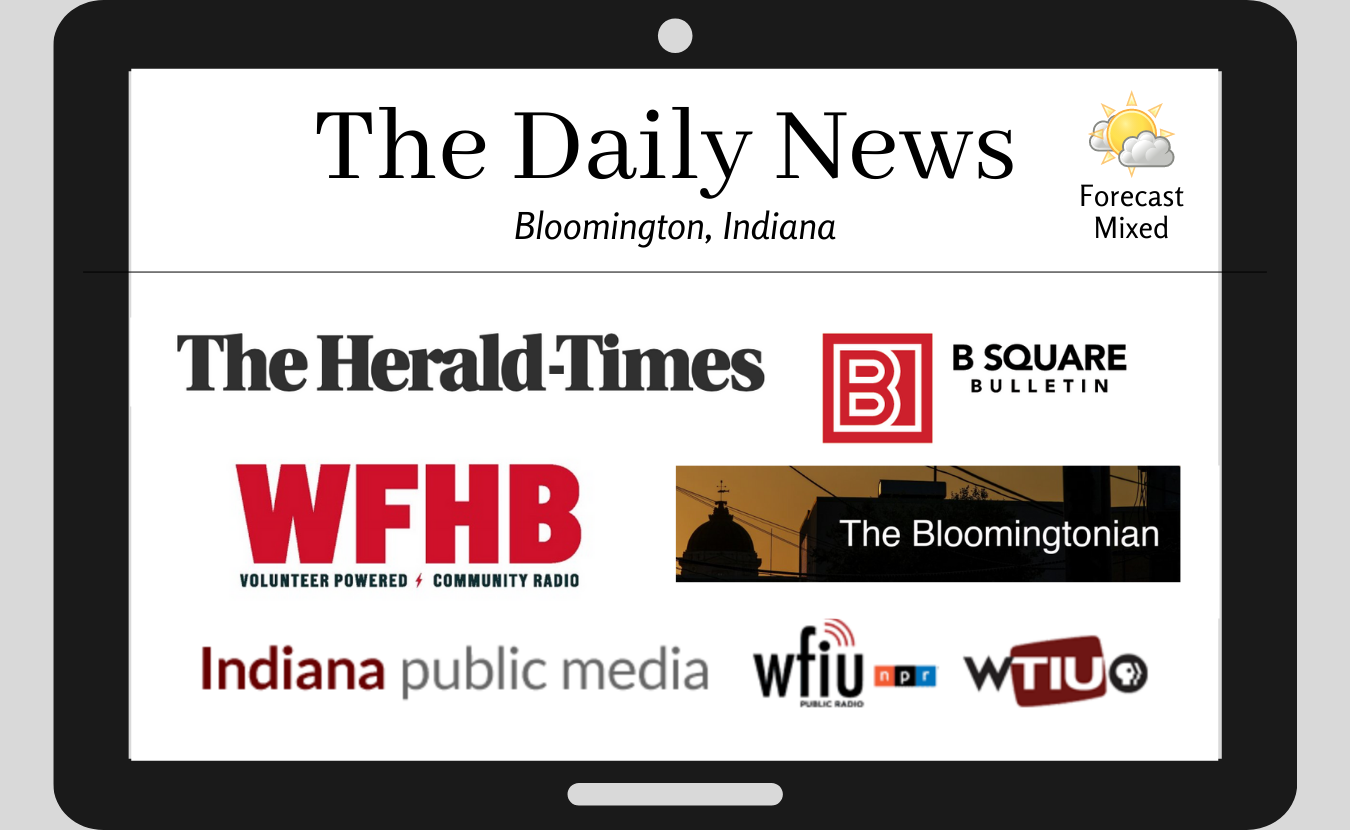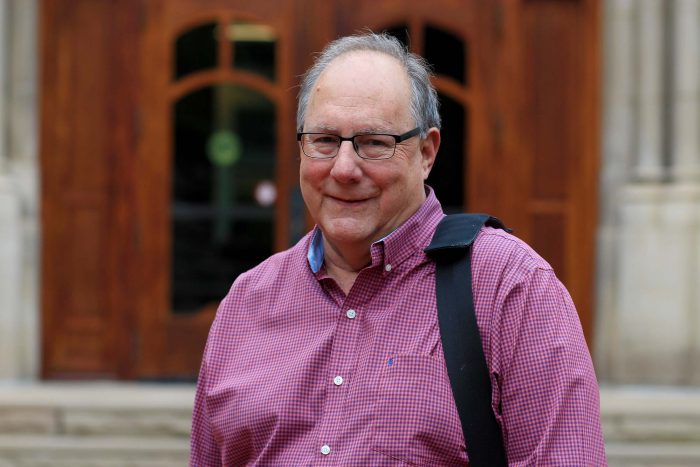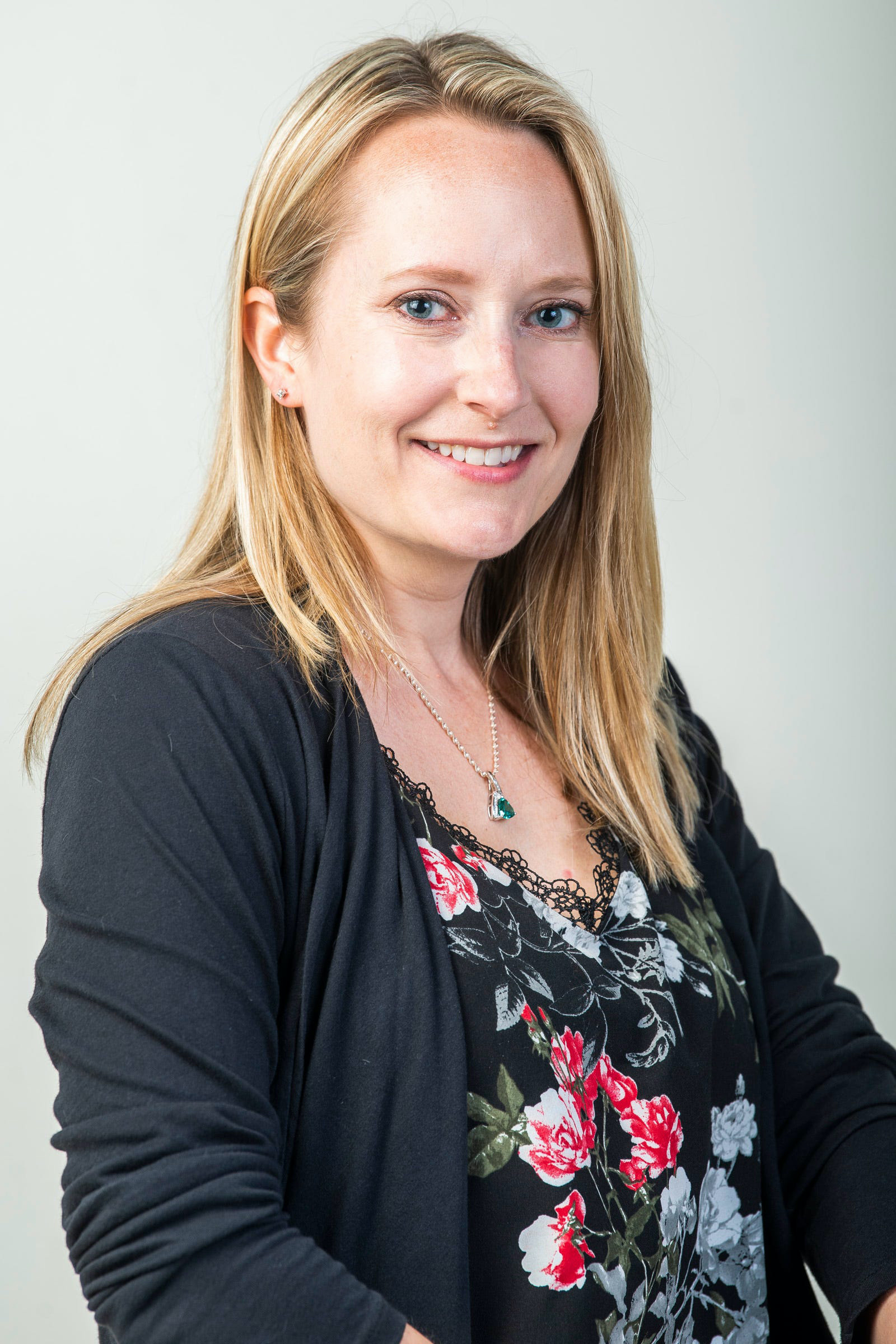The Herald-Times building on South Walnut Street is mostly dark. Cubicles and offices sit empty. An outdoor sign directs visitors to the front of the building, but there are no visitors. The doors are locked. The cavernous old newsroom, once filled with the noise and activity of 50 people, is deserted.
Hidden away in a small area that used to be part of the advertising department, a cluster of reporters and sportswriters work on stories. “We are a newsroom of twelve,” Herald-Times News Director Jill Bond says.
Going to work in a mostly empty building can feel demoralizing, especially for longtime staff, Bond admitted. “We keep our attitudes positive, though,” she told me. “We celebrate our wins, and we make sure to deliver compliments to each other and to call out the good work.”
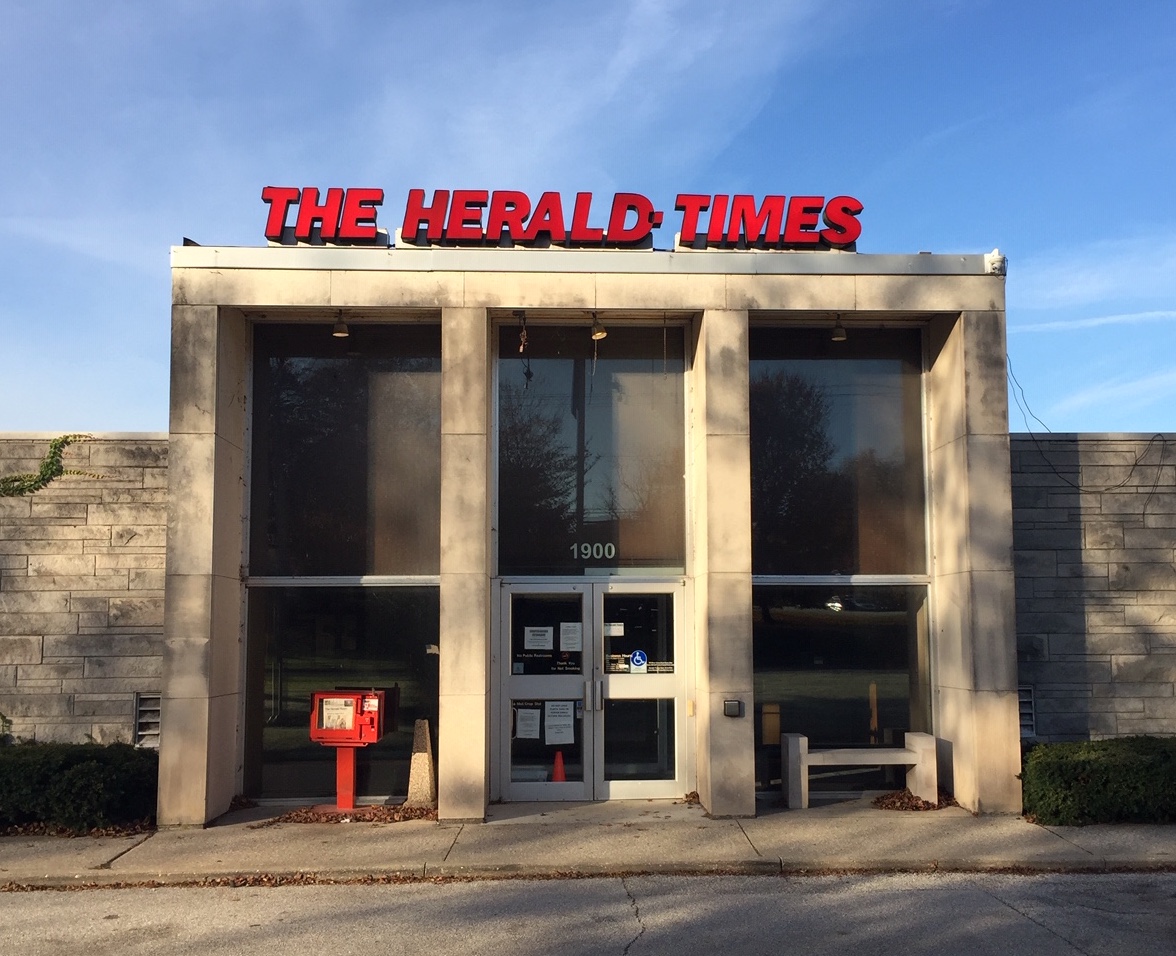
The Herald-Times building at 1900 S. Walnut St. was built in 1961. Printing operations moved to Indianapolis in 2020, and the news staff is planning to move to a smaller location in 2022. | Limestone Post
The Herald-Times news staff hopes to move to new, smaller quarters by mid-2022. Meanwhile, they continue to produce a daily print newspaper while posting stories to the paper’s website and updating social media. But the H-T can’t be all things to all people.
“We have to own a portion of the media landscape,” Bond says. “We can’t own the whole thing. We don’t have enough staff to do that.”
Other news sources are increasingly sharing that landscape, including public broadcasters WFIU and WTIU, which have expanded their local news operations; the Indiana Daily Student, the award-winning Indiana University student newspaper; WFHB, a “volunteer-powered” community radio station; and a pair of one-man operations that arose in the past two years, The B Square Bulletin and The Bloomingtonian.
“I think we are all different in the way we are reporting stories, and that’s great,” says Sara Wittmeyer, news bureau chief for WFIU and WTIU.
The shrinkage of the Herald-Times is emblematic of what’s happened across the United States. Over 2,000 U.S. newspapers have shut down in the past 15 years, according to Brookings Institution analyst Clara Hendrickson. Others have reduced staff, cut back on coverage, and reduced home delivery.
The Pew Research Center’s State of the News Media project reports that paid circulation of daily newspapers, including digital as well as print, is less than half of what it was between 1970 and 1990. Newspaper employment has declined every year since 2006, falling by more than half.
Two hundred of the more than 3,000 counties in the United States no longer have a daily or weekly newspaper. Scholars refer to these communities as news deserts, and the trend has consequences. Studies have found the loss of local news leads to higher costs for government bond issues, fewer candidates running for public office, lower turnout in elections, and more political polarization.

Jason Peifer is an assistant professor of journalism in the Indiana University Media School. | Courtesy photo
When there’s not a robust local newspaper, “there’s not a shared experience,” says Jason Peifer, an assistant professor of journalism in the Indiana University Media School. “It just lends itself to isolating ourselves in our own social spheres.”
Local newspapers were stable and profitable not long ago. Then came the internet and other changes. Bob Zaltsberg, who retired in January 2019 after 33 years as editor of the Herald-Times, says three trends, all of them technology related, upended the industry.
First, the internet gave consumers access to multiple news sources, many of them free. Second, younger generations came to expect news on screens, and newspapers were slow to adapt. “Lots of those people that were in the obits on page two were our subscribers, and they weren’t being replaced,” Zaltsberg says.
Finally, advertisers, who had provided most newspaper revenue, found cheaper and more effective platforms. Car dealers and real estate brokers moved online. Big department stores closed or downsized. Nationwide, newspaper advertising revenue nose-dived: from over $50 billion in the early 2000s to less than $9 billion in 2020.
“It just started happening and it started accelerating, and here we are,” Zaltsberg says.
The Herald-Times newsroom peaked at 51 full- and part-time employees, including reporters, editors, photographers, page designers, clerks, and librarians. When Zaltsberg retired, the number was down to 29. Today, it’s 12. Other departments also shrank. A majority of H-T employees once worked in ad sales, business, circulation, production, and printing jobs, many of which have been eliminated.
For nearly 50 years, the Herald-Times was owned by the Schurz Corporation, a family-owned media company anchored by the South Bend Tribune. In January 2019, the company announced it was selling its newspapers to GateHouse Media, a news publishing giant.
Ten months later, GateHouse acquired Gannett Co., publisher of USA Today and many other papers, in a cash-and-stock deal valued at about $1.2 billion. The merged company, rebranded Gannett, includes about 250 daily newspapers and numerous weeklies. Its Indiana properties include the Indianapolis Star and daily papers in South Bend, Evansville, Lafayette, Muncie, and Richmond.
With the sale, more change came faster. Longtime employees took buyouts or had their jobs eliminated. Page editing, production, and business operations were moved to other Gannett properties.
Corporate ownership means “a seismic shift in what readers can expect,” Zaltsberg says. “And I say that because Gannett’s for-profit model is based on serving stockholders. It’s not based on serving a family or staff or a community. It’s based on serving stockholders, and that just changes the calculus.”
He’s careful to not criticize H-T staff, which he credits with producing solid journalism. “But I worry about their capacity to do meaningful stories with a staff that size,” he says. “Because with a staff our size, even at our peak, it was really difficult to do the real deep dives.”
Shifting newsroom priorities
Jill Bond stepped into those challenges when she became the Herald-Times news director in April 2021. An Iowa native, she earned a journalism degree at the University of Oregon, then worked as a reporter and editor at the Herald and News in Klamath Falls, a city of 21,000 in southern Oregon. After five years, she moved to Indiana and became city editor of the Kokomo Tribune.
In 2016, she decided it was time to leave newspapers. She enrolled in IU Bloomington, earned a Master of Public Affairs degree and took a job with the U.S. Census Bureau. When Gannett advertised for a newsroom leader in Bloomington, she took her time deciding to apply.
“I wasn’t looking to come back to journalism,” she says.
As a Bloomington resident and Herald-Times reader, she was sometimes disappointed with the paper. She once called a previous editor, Rich Jackson, to complain. Then it became her turn to hear complaints. She sometimes gets phone calls about late deliveries, billing problems, and other issues. There’s no one else in the building whose job is to answer the phone.
Bond says the biggest challenge is figuring out how to deploy limited resources.
“It’s tough,” she says. “Every single day is a tremendous challenge to try to decide what we’re going to do with that time we have today. There are so many stories in our community, so many more than we can possibly cover. Even if we had unlimited hours, if we never slept, we still could not cover everything.”
That means a lot of Bond’s job involves saying no: to people and organizations that want their news events covered, and to reporters who want to chase one more story but can’t in a 40-hour week.
Bond says the news staff’s priority is “to create space for investigations and in-depth reporting.” That’s because readers are more likely to subscribe to a paper that provides deep coverage of local news that they care about. And getting readers to subscribe is the name of the game. Gannett has 1.4 million digital subscribers nationwide. It has set a goal of growing that number to 10 million by 2025.
Bond endorses looking to readers, not advertisers, for revenue. “When you think about it,” she says, “wouldn’t it be better to be supported by the consumers of your product than the businesses that may want something in exchange?”
But with the small staff, popular features have been eliminated or replaced, including an events calendar that took a lot of time to assemble and routine stories about community events. “We still think those things are valuable,” Bond says, “but we just don’t have the resources to do the type of things we used to do.”
The paper dropped its police beat column and cut back on crime news, decisions that Bond attributes in part to Gannett’s approach to ethics. It’s not fair or ethical, she says, to run stories about people who are charged with crimes, tarnishing their reputations, when they may not be convicted.
If Gannett is promoting digital subscriptions, will it eliminate the print newspaper? Almost everyone thinks print will eventually go the way of the dinosaurs. Newspapers in major cities, including Pittsburgh, Salt Lake City, Cleveland, New Orleans, and Little Rock, have abandoned seven-day-per-week printing and delivery. Some papers are considering Sunday-only print editions.
“I don’t think there is any intention of reducing the frequency of the Herald-Times,” Bond says. “Especially knowing a lot of our readership is using the print product.”
Bond addresses some of the changes in a recent opinion column. While the staff is small, she writes, “I am dedicated to protecting the journalists who work here. I care about their well being and have made changes aimed at keeping them mentally and physically healthy.”
Outside design and production, local beat reporters
One of biggest changes Gannett made to the Herald-Times was to transfer much of the page design work to Gannett design hubs at other locations. There have been glitches. This summer, the same page appeared multiple times, on different days. A front-page story on the 10th anniversary of the disappearance of IU student Lauren Spierer referred to “the University of Indiana.” Recently the same letter to the editor appeared twice on the same day, under different headlines.
Bond says communication with the design hub is improving. An Indiana-based “planner” assigned to the Texas team helps identify appropriate content for the Herald-Times and other Indiana papers. A former H-T staffer, now part of a Gannett “digital optimization team,” helps keep the website fresh.
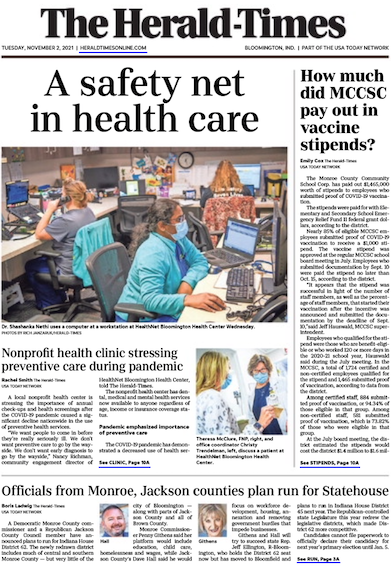
A family-owned media company, the Schurz Corporation, owned The Herald-Times for nearly 50 years before selling its newspapers to GateHouse Media. Ten months later, GateHouse bought Gannett Corporation and rebranded the company as Gannett. Calling itself a “digitally focused media and marketing solutions company,” Gannett owns The Herald-Times, Spencer Evening World, The Indianapolis Star, USA Today, and hundreds of other media outlets in 46 states.
Arguably a bigger change came in early 2020, when Gannett shut down the local printing press and moved newspaper production to Indianapolis. Deadlines shifted, and stories need to be turned in by mid-afternoon to make the next day’s paper. Results of Friday high-school football games are posted online but don’t appear in print until Sundays. Wednesday city council coverage publishes on Fridays.
As a result, there are more analyses and feature stories in the sports section. Those and the longer news stories that the H-T favors — like series on local housing costs and police staffing and a profile of a Brown County shooting victim — aren’t tied to deadlines.
Some of the Gannett changes have been positive. The website is cleaner and more user-friendly than the old H-T site. (There are fewer annoying pop-up ads but more annoying “advertorial” content). State news is stronger. Bloomington and Indianapolis sportswriters team up to cover IU football. H-T subscribers were able to read a voluminous, blockbuster Indy Star investigative series on deaths in Indiana’s county jails.
The Herald-Times still has local beat reporters assigned to city and county government, police and courts, and the environment, and they do a good job. Possibly unique among Indiana newspapers, it has reporters covering both K-12 and higher education. A freelancer writes about the arts.
But guest columns and editorials from USA Today and other Gannett papers have mostly replaced staff-written editorials and opinion pieces. A larger font size means there are fewer words in the paper. News from other Gannett papers sometimes crowds out local content. And a smaller staff means less local news.
“There isn’t the volume of local stories that there used to be,” says Geoff McKim, a Monroe County Council member. “The reporters do a good job; there just aren’t as many of them.”
As an elected official and Herald-Times subscriber, McKim misses day-to-day, process-oriented news coverage: meeting advance stories, detailed reporting on city and county budgets, etc.
“Local government does a lot of things that make some people mad,” he says. “They get really frustrated when they find out too late to do anything about it. People ought to be able to have a say about local government in an informed manner and in a timely manner.”
And news about routine events and developments, while they may seem trivial, are vital, as Elaine Godfrey argues in The Atlantic, describing the decline of the Burlington, Iowa, Hawk Eye, after it was taken over by GateHouse and Gannett. “These stories are the connective tissue of a community,” she writes. “They introduce people to their neighbors, and they encourage readers to listen to and empathize with one another.… As local news crumbles, so does our tether to one another.”
‘Local news is vital’
While the Herald-Times has shrunk, the news operation at WFIU radio and WTIU television has grown. News Bureau Chief Sara Wittmeyer says the IU-affiliated public broadcasting outlet had a news staff of four when she arrived 12 years ago. “We couldn’t cover all the news that was happening,” she says.
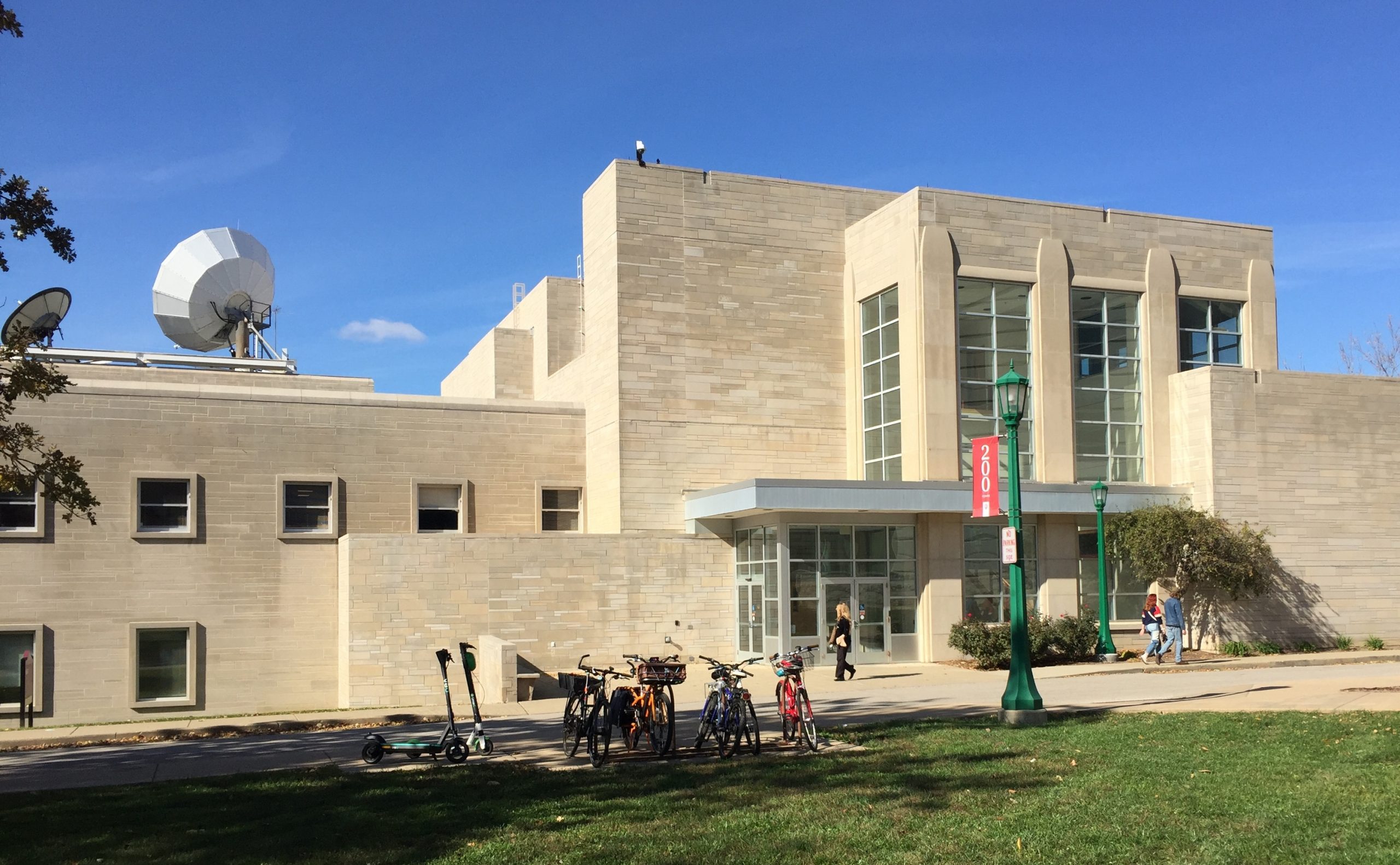
WFIU and WTIU broadcast from the Radio-Television Center on the IU Bloomington campus at West 7th Street. | Photo by Limestone Post
Now the staff has quadrupled. It includes a full-time Statehouse reporter, Bloomington-based reporters covering education and the environment, a reporter covering rural affairs, another doing special projects, and a former H-T sportswriter. The team added Zaltsberg as a part-time editor to direct projects, including City Limits: Bloomington, which answers questions raised by listeners.
WFIU and WTIU, which operate a combined radio and TV newsroom, have a statewide reach. The WFIU signal reaches 20 Indiana counties, and it has transmitters in Terre Haute, Kokomo, Columbus, and Seymour. The staff produces daily radio newscasts, online stories, and the weekly Indiana Newsdesk TV news program. The stations partner with other public broadcasters in Indiana, and their news website includes stories from WFYI in Indianapolis and public stations in Fort Wayne, Lafayette, and elsewhere.
When she arrived, Wittmeyer says, it didn’t make sense to focus on Bloomington news, because the Herald-Times owned that franchise. But things have changed.
“We think that Bloomington is now underserved,” she says. “We are shifting focus from our statewide approach and bringing our reporters in more locally.”
Local news is vital, Wittmeyer says, because people want and need to know what’s going on in their community, from details about the Great Glass Pumpkin Patch on the courthouse lawn to the count of COVID-19 cases in local schools. Local news also plays an important watchdog function for government and business, she says, citing WFIU reporting that showed a rural electric co-op with customers in Monroe County had some of the nation’s highest electric rates.
She says the contraction of the Herald-Times created “an opportunity,” but it wasn’t cause for celebration. “The H-T has some great reporters,” she says. “Like all journalists, they’re trying to do the best they can with really limited resources. I hope people continue to subscribe to the Herald-Times and that they also watch and listen to our news.”
Daily community journalism
Community radio station WFHB relies on dozens of volunteers to produce a daily local newscast and 13 locally produced public affairs programs. News Director Kade Young says the volunteer-driven news programming exemplifies community journalism.
There are drawbacks to the approach, he says, “but the upside is, when you do get folks who are interested and engaged, you’re getting folks who are doing it for the passion.”
The station’s newscast airs four nights a week and includes local government stories and other staples of local daily news. Aside from Young and an assistant news director, the news staff are volunteers: a mix of local residents, some of them of retirement age, and IU students.
“We really want to be a training ground,” says Young, a 2019 IU graduate who started at the station as a volunteer. “We want people to get experience and cover true, impactful stories that make a difference in someone’s life.”
In keeping with WFHB’s mission — to provide an open forum for discussion of ideas and issues and to celebrate cultural diversity — there’s an emphasis on stories about the environment and social justice. The station often covers protests, rallies, and town-hall meetings.
“We aspire to lend the mic out, even on the daily local news, to voices that you don’t often hear or that might get distorted in the corporate news,” Young says.
‘Bootstrapping’ local coverage
Like Jill Bond, Dave Askins didn’t come to Bloomington to practice journalism.
“I didn’t move here to start a one-person news outlet,” says Askins, who runs The B Square Bulletin. “But I wasn’t able to find anything else that sort of fit my skill set. So, I thought, I’ll give this a shot.”
But then he never set out to be a journalist. A Columbus, Indiana, native, he studied math as an undergraduate and earned a master’s in German linguistics from IU. He worked a variety of jobs: at an animal shelter, a survey research firm, and a grocery store, checking in items on a receiving dock.
Living in Ann Arbor, Michigan, where his wife, Mary Morgan, had taken a job with the Ann Arbor News, Askins built a teeter-totter in their back yard, invited people to ride it, interviewed them as they did, and published the results in a blog. That was his start in reporting and writing.
Fox six years, he and Morgan produced the Ann Arbor Chronicle, an online news outlet focused on local government. After they shut it down, Askins worked at two small newspapers in South Dakota while Morgan ran a local nonprofit. In 2019, they moved to Bloomington, where they had met years earlier. (Morgan is director of advocacy and public policy for the Greater Bloomington Chamber of Commerce.)
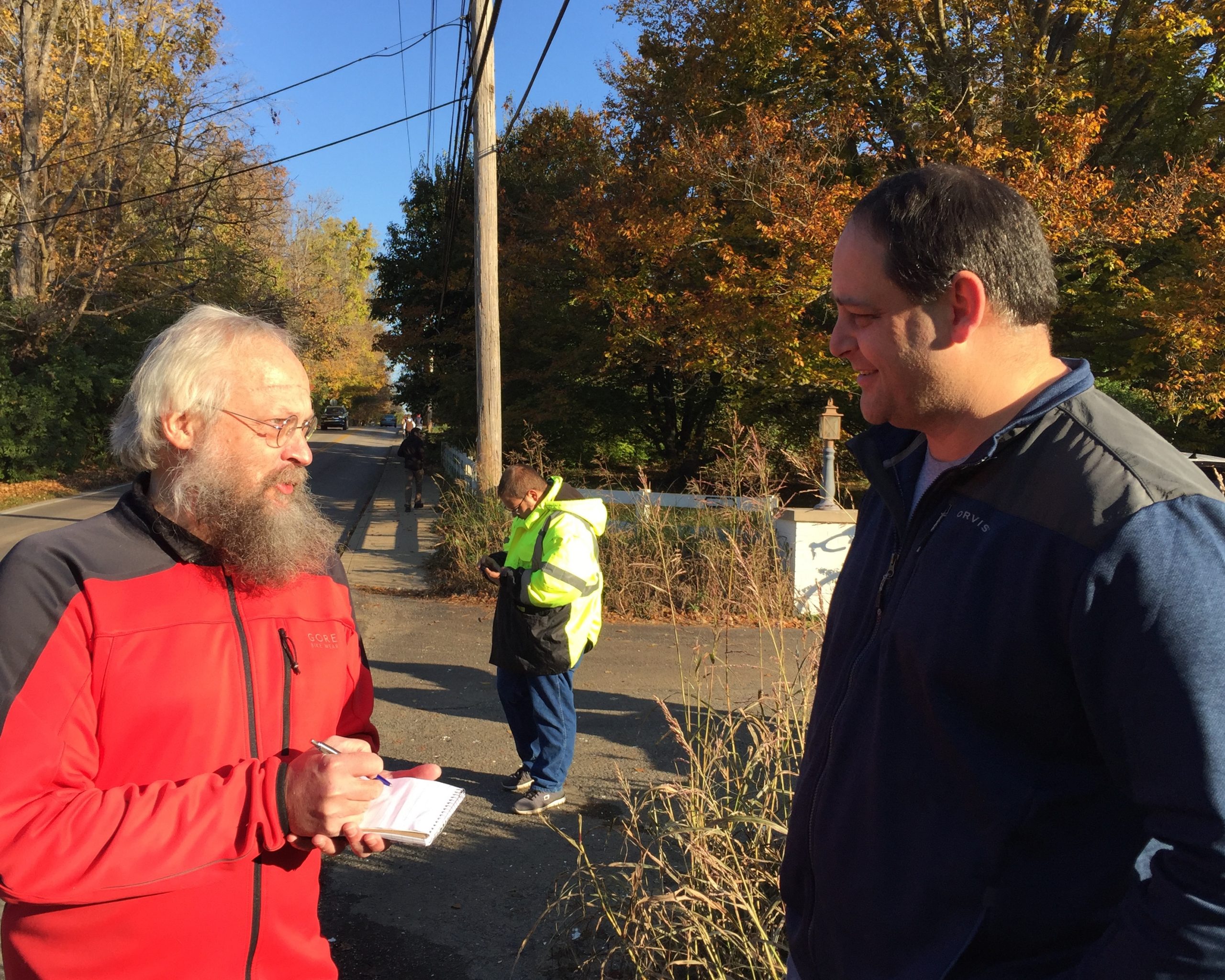
Dave Askins (left) interviews the chief of the Bloomington Fire Department, Jason Moore. Askins launched The B Square Bulletin in 2019. | Limestone Post
At The B Square Bulletin, Askins holds a magnifying glass to local government. He attends countless meetings and produces daily news stories. He doesn’t shy away from what some might consider trivia. He wrote about a residential rental company’s appeal of a city citation for having poison ivy on its property and searched through 155 city council resolutions to see if Mayor John Hamilton had affixed objections when he signed them.
“My goal is to report the routine, normal, boring stuff in a way that people can get better access to the functioning of their own government,” he says over coffee at the downtown Inkwell Café.
Not that the stories are boring. The writing is lively and spiced with detail. Askins doesn’t sensationalize the ever-present Bloomington sniping — between city council members, between the council and the mayor, between city and county — but a reader can’t miss it.
Askins puts a premium on maps, graphics, and links to original documents. He files public-records requests and has used them to reveal the mayor’s approval of a military training exercise and the process behind the city council’s hiring of a new attorney. He’s also devoting a lot of attention to his B There or B Square calendar, with links to meetings and community events.
The B Square Bulletin’s business model is voluntary reader support. Anyone can go to the website and read the stories without paying. Askins invites readers to make monthly contributions via an online “Support B Square” link.
“If you focus exclusively on serving the information needs of readers and nothing else, not trying to connect advertisers with customers, then there is some subset of people who are willing to pay money for that, even though they don’t have to,” he says.
The model is working, after a fashion, but the reporting and writing take a lot of effort. “It literally is all-consuming,” Askins says. “There’s not a moment of the day when I’m not working on something.”
He would like to expand to a full-service local news operation with coverage of education, business, and other beats. But adding staff who meet his standards would take considerably more revenue, which would require more voluntary supporters.
“That’s what I struggle with,” Askins says. “How to bootstrap that additional coverage.”
Covering the Bloomington mindset
Jeremy Hogan started taking pictures when he was a junior high student in Porterville, California; he would ditch school to photograph skateboarders. He worked his way through San Jose State University, studying photojournalism. He started The Bloomingtonian, an online site specializing in visual journalism and breaking local news, after being laid off by the Herald-Times, where he worked for over 20 years.
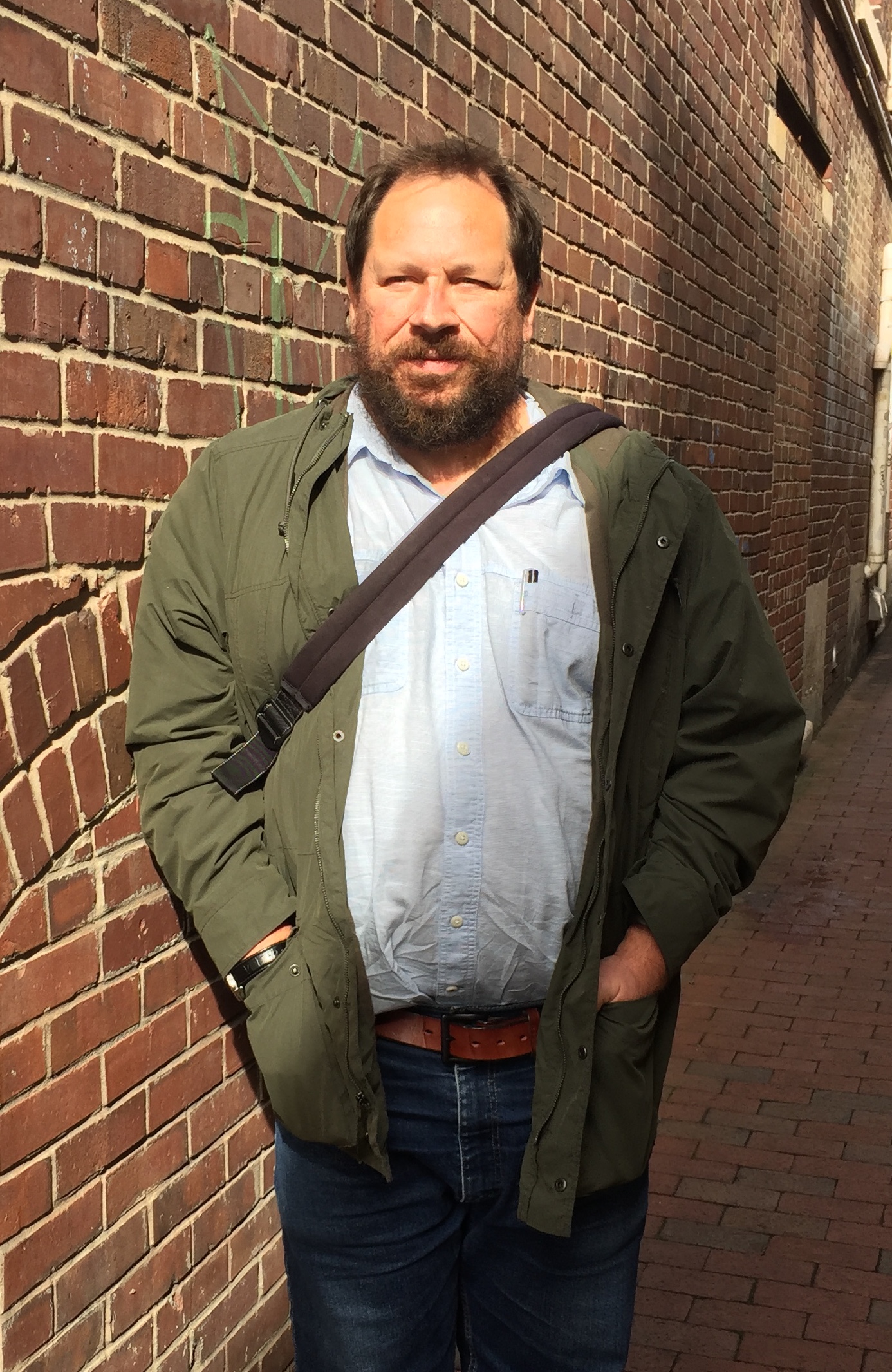
Photojournalist Jeremy Hogan started The Bloomingtonian after he was laid off from the Herald-Times, where he had worked for more than 20 years. | Photo by Limestone Post
“I’m used to being scrappy and doing things on my own,” he says.
Hogan’s job was eliminated when the newspaper was sold to GateHouse. He was at home, nursing a respiratory infection, when a manager called to give him the news.
“The day I was laid off, I went out and photographed the polar vortex,” he says. “I started going out and taking weather pictures out of defiance.”
A friend helped set up a website, and The Bloomingtonian was born. The name made a statement, possibly aimed at GateHouse and Gannett: “We’re not like the rest of Indiana. It’s a different mindset. You can’t come into this news market with the mindset of a different news market.”
When he was at the Herald-Times, Hogan did extensive freelance photography and videography to supplement his income. He worked on his days off and took vacation to cover national news, including presidential campaigns and Democratic and Republican conventions. He traveled to Mongolia to take feature photographs and to Ukraine to cover the Russo-Ukrainian War.
In Bloomington he has made a specialty of shooting protests, rallies, and marginalized populations, including people experiencing homelessness. While the Herald-Times has stepped back from daily police news, the Bloomingtonian has leaned in. Hogan follows late-night police radio traffic, shows up at fires and shootings, and attends daily media briefings at the police station.
Hogan takes stunning photographs and works incredibly hard. (I worked with him for 10 years and I know this firsthand). He shows up wherever there’s a story that can be told by visual journalism. He has an obsessive nose for news. But making a living as a one-person photojournalism operation is a struggle.
“I’ll be honest, there’s a certain satisfaction in scooping the newspaper that laid me off,” he says. “But that doesn’t pay the bills.”
The Bloomingtonian “doesn’t make enough to justify doing it full time, even though I probably put full time into it,” he says. Most of his audience accesses the site through Facebook, and the social media platform’s algorithms valorize outrage and controversy. Hogan spends a lot of time policing name-calling and rude comments on the Bloomingtonian’s site.
He’s not optimistic about the state of journalism. “There’s this theory out there that there will be an army of citizen journalists covering the news,” he says. “That’s not true. I haven’t seen an army of citizen journalists out there covering stuff at one o’clock in the morning.”
Upending the daily news business model
I was a reporter at the Herald-Times from 1980 to 2007. It’s easy to romanticize that era, but we made mistakes and missed opportunities. My colleagues and I were sure we were underpaid, overworked, and underappreciated. We complained about lacking the time and resources to do important stories. What Elaine Godfrey wrote about the Burlington Hawk Eye could also be said about the H-T: “Conservatives in town called it a liberal rag, and some lefties didn’t think it was progressive enough.”
Needless to say, I sympathize with the current Herald-Times staff, several of whom are my friends. I can only imagine how difficult their jobs are with a newsroom of 12.
I like seeing WFIU and WTIU producing more local news stories. I love Dave Askins’ deep dives into local government and Jeremy Hogan’s compelling photos and fierce attachment to the mission of journalism. But I still want there to be a local, daily newspaper — in print or online — that helps me make sense of the place where I live. I keep reading the Herald-Times because of the good work the news staff is doing.
But what is its future when the paper’s owner is responsible primarily to its shareholders? Gannett’s reputation isn’t as unsavory as that of Alden Global Capital, the “vulture” hedge fund that bought the Chicago Tribune and its affiliates, but Gannett is known for aggressive cost-cutting.
And it’s impossible to overstate what’s lost when local news coverage goes away.
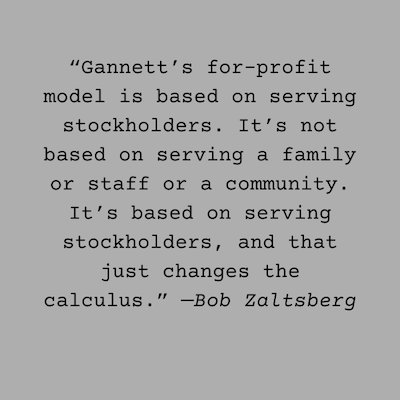 Political scientist Eitan Hersh, in his book Politics Is for Power, ties the decline in local news to America’s growing partisan divides. Local news doesn’t inspire “clicks and likes and shares” online, he argues, but it’s essential for understanding our communities and knowing our neighbors. People who get all their news from national outlets or social media are more likely to identify with political parties and partisan causes and less likely to engage with people who have different views.
Political scientist Eitan Hersh, in his book Politics Is for Power, ties the decline in local news to America’s growing partisan divides. Local news doesn’t inspire “clicks and likes and shares” online, he argues, but it’s essential for understanding our communities and knowing our neighbors. People who get all their news from national outlets or social media are more likely to identify with political parties and partisan causes and less likely to engage with people who have different views.
Kevin Corcoran, a former Indianapolis Star reporter now with the Lumina Foundation, puts it this way: As local news disappears, “people are becoming less tethered to their communities, destabilizing our fragile and divided democracy.”
Is there another path? Peifer, the IU journalism professor, says the U.S. tradition of private ownership of the news media conflicts with the concept of news as a public good. “If we’re talking about pie-in-the-sky dreams,” he says, “I really think the business model needs to be upended.”
There has been encouraging growth in nonprofit, civic-minded journalism, as Steve Higgs, a former H-T reporter who teaches at the IU Media School, has documented. Pro Publica, which launched in 2008, has won six Pulitzer Prizes. Chalkbeat provides deep coverage of education, including in Indianapolis. The Marshall Project covers criminal justice. The Texas Tribune, El Paso Matters, the Voice of San Diego, and MinnPost produce strong local and state news. Smaller sites like NC Policy Watch and Wisconsin Watch break important stories. Close to home, the Indiana Citizen reports on state government and politics.
Many of the nonprofits specialize in specific topics or investigations. Some have generous funding from wealthy philanthropies that focus on national themes. For the most part, you won’t find them at the local school board meeting or high school basketball game. They aren’t there for what Askins calls “the routine, normal, boring stuff.”
That could change, however, as more people realize the risk of losing local news. The American Journalism Project, a “venture philanthropy” organization, hopes to invest $1 billion in local news, with an emphasis on nonprofit platforms.
Another idea is government assistance for businesses and organizations that provide local news. Legislation called the Local Journalism Sustainability Act, which has drawn bipartisan support in the House and Senate, would provide tax breaks for subscriptions, advertising, and employment. It has been criticized, however, for failing to address communities that are underserved by existing outlets.
People who try to predict the future of news usually end up looking foolish. We can imagine a local news system that prioritizes journalism over profits, but it’s not obvious how we’ll get there.
“We’re in a painful period,” says Peifer. “But it’s also true that we’ve gone through a lot of models of news and journalism over the scope of 200 years. I certainly have a lot of concerns, but I also think news isn’t going anywhere. It’s just going to look different.”

